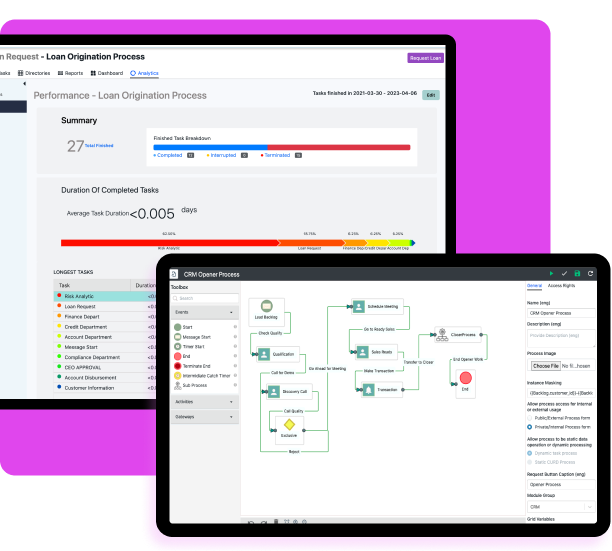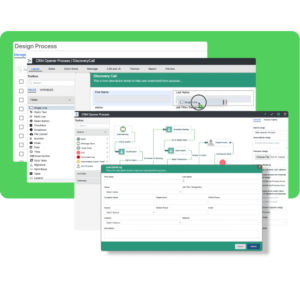Innovate your Business with thrilling Workflow Technology by BitAffix

By Zeeshan Bhukhari - 3 minute read
Table of Contents
Introduction
Nowadays rapidly evolving business landscape, efficiency is paramount for organizations focusing on maintaining a competitive edge. With every passing moment, the value of improved operations becomes more evident. Workflow technology is a critical component as a solution to this challenge, offering businesses a streamlined approach to managing processes, automating tasks, and maximizing productivity. This article delves into the transformative potential of workflow technology, with a spotlight on BitAffix, a leading platform revolutionizing business operations.
Understanding Workflow Technology
In the workflow, the sequences are usually included to perform well-defined for the documents, tasks, or request traverses before reaching a final decision, whether it’s approval or rejection. in the process of workflow, It checks all these steps and serves as checkpoints & gateways, it has to ensure that all stage of the process is functionally properly performed and reviewed. It checks all the processes while running these steps, including validation, data entry, review, and approval. Mostly, workflows include multiple approvers or reviewers, with their each role and responsibilities in the process. Other sections and teams within the organization deliver different commands, bringing varied perspectives and expertise to the table. workflows often include conditions or rules that dictate the flow of the process additionally, such as escalation procedures for unresolved issues or automatic notifications for pending tasks.
The best part of workflow technology is its ability to facilitate the creation of specific workflows tailored to the unique needs of each organization or process. Users can define the sequence of steps, assign roles and permissions to participants, and set conditions for decision-making. Customization ensures that workflows align closely with organizational objectives and compliance requirements at this level. Moreover, workflows are crucial in ensuring that work is completed to a high standard and that key stakeholders are involved in the process approval. In simpler terms, when organizations make it necessary for specific users or groups to give their approval at different points of the process, they can ensure that responsibilities are clear and that there is proper supervision. This helps in lowering the chances of mistakes or things being missed. The overall, approval workflows streamline processes, minimizing delays, and ensuring adherence to organizational policies and standards. which provides a structured framework for managing critical tasks and projects, boosting organizations to achieve their objectives efficiently and effectively.
Role of Workflow Technology
•Revolutionizing Workflow Processes – Workflow Technology automates mundane tasks, allowing employees to focus on value-added activities. A study by indicated that companies facing workflow automation witnessed a 90% reduction in processing time for routine tasks if Workflow Processes.
•Promoting Collaboration – Workflow technology fosters collaboration by breaking down departmental silos. reference by Harvard Business Review suggests that businesses with strong collaborative cultures are five times more likely to be high-performing with automated workflow.
•Mitigating Errors – Workflow technology minimizes the risk of errors by ensuring consistency and accuracy in task execution. With reference, the study by IBM found that workflow automation led to a 50-75% reduction in errors and bugs.
•Enhancing Performance – By streamlining workflows, organizations can achieve peak performance and gain a competitive advantage. On behalf of Forrester Research Reports which highlighted that businesses are leveraging workflow technology observed over a 25-30% improvement in operational efficiency.
How Workflow Technology Can Impact Your Organization’s Growth
•Enhanced Efficiency – Workflow technology automates repetitive tasks, allowing employees to focus on high-value activities, ultimately leading to increased productivity and growth.
•Improved Collaboration – By streamlining communication and coordination between departments or teams, workflow technology fosters collaboration, leading to better decision-making and innovation.
•Scalability – Workflow technology enables organizations to scale their operations efficiently, accommodating growth without sacrificing productivity or quality.
•Data-Driven Insights – Workflow technology provides valuable insights into process performance and bottlenecks, empowering organizations to make data-driven decisions that drive growth and optimization.
•Competitive Advantage – Organizations that leverage workflow technology often gain a competitive edge by optimizing processes, reducing costs, and delivering superior products or services to customers.
Benefits for Overall Task Management
•Scheduling and Time Tracking.
•Automates task scheduling and allocation, ensuring efficient use of time and resources.
•Tracks time spent on each task, allowing for better resource management and workload balancing.
•Enables real-time monitoring of task progress, facilitating timely adjustments and optimizations.
Diverse Workflow Technology Patterns
•Flexibility – Workflow technology can adapt to various workflow patterns, including sequential, parallel, or branching workflows, accommodating diverse organizational needs.
•Customization – Users can design workflows tailored to specific tasks or processes, ensuring optimal efficiency and adherence to organizational requirements.
•Integration – Workflow technology seamlessly integrates with existing systems and tools, allowing for the incorporation of diverse workflow patterns into the overall organizational workflow.
•Standardization – Workflow technology helps standardize processes across departments or teams, ensuring consistency and compliance with organizational standards and regulations.
BitAffix Revolutionizes Workflow Technology Automation
BitAffix offers an advanced solution for workflow automation, empowering organizations to optimize their operations and achieve greater efficiency. Which introduces a user-friendly interface and robust features, BitAffix simplifies the process of designing, managing, and optimizing workflows. BitAffix case study conducted by revealed that clients experienced a 40% increase in productivity after implementing in their platform.
•User-Friendly Interface: BitAffix’s intuitive interface requires minimal technical expertise, enabling users to quickly adapt to the platform. According to the Gartner survey, 90% of users have reported increased efficiency after using BitAffix.
•Comprehensive Features – BitAffix provides a comprehensive suite of features tailored for workflow management, including task automation, process monitoring, and real-time analytics. A comparison study by TechRadar rated BitAffix as the most feature-rich platform in the market.
•Seamless Integration – BitAffix seamlessly integrates with existing systems and software applications, ensuring smooth data flow and interoperability across the organization. A case study by IDC found that organizations using BitAffix reported a 30% reduction in integration costs.
•Automation of Complex Processes – BitAffix empowers organizations to automate even the most intricate processes, enabling them to achieve greater operational efficiency and agility. the study by Forrester Consulting and revealed that 80% of organizations experienced improved process agility after implementing BitAffix workflow solution.
•Enhanced Productivity – By automating tasks and streamlining processes, BitAffix drives significant enhancements in productivity. According to a study by PwC, organizations using BitAffix reported a 35% increase in productivity within the first year of implementation.
Pros and Cons of Workflow Technology
Pros
• Increases efficiency and productivity
• Reduces manual errors
• Facilitates better collaboration
• Streamlines business processes
• Improves decision-making through data insights
Cons
• Initial setup and implementation may require time and resources
• Complex workflows may require specialized expertise
• Over-reliance on automation may lead to complacency
• Security and privacy concerns with sensitive data
• Compatibility issues with legacy systems
The workflow technology delivers immense potential for your businesses to streamline operations and achieve greater efficiency. In nowadays BitAffix modified platform is at the front hand of this Feature, BitAffix providing organizations with the tools they need to automate their processes, improve productivity, and stay competitive in today’s landscape. With workflow technology, businesses can unlock new levels of efficiency and drive growth in the modern world.
How can the workflow technology impact in every organization's growth?
It can noteworthy impact on every organization’s growth by enhancing the operational effectiveness of the process, improving the productivity, and delivering the better decision-making. By workflow automating repetitive tasks and streamlining processes, workflow technology allows organizations to focus their resources on Strongest matches initiatives that drive growth. Additionally, workflow automation enables faster task completion, refines and reduces errors, and enhances collaboration in workflow, all of which contribute to overall business success and expansion
What are the overall benefits of workflow technology for tasks?
It offers several benefits for tasks, including:
• Scheduling and Time Tracking: It allows organizations to schedule tasks efficiently and track their progress in real-time, ensuring timely completion and optimal resource allocation.
• Diverse Workflow Patterns: It is designed to handle diverse workflow patterns, ranging from simple linear processes to complex branching workflows.
• Approval Workflow: An approval workflow involves a series of steps that a document, task, or request goes through before it can be approved or rejected. while Workflow Technology work is completed to a high standard and involves the key stakeholders in the Workflow Technology, thereby enhancing task quality and compliance for the Workflow Technology.
How does workflow technology contribute to better collaboration within organizations?
It enhances collaboration within organizations by breaking down breakdowns between departments and facilitating seamless communication and their information sharing. Workflow provides visibility in the integrator of tasks and enables collaboration across the teams and members, workflow technology fosters a culture of teamwork and accountability. This, in turn, leads to improved coordination, faster decision-making, and extremely, better outcomes for the organization as a whole.
What factors should organizations consider when implementing workflow technology?
• Resistance to Change: Employees may resist adopting new technology or changes to established processes, leading to slow adoption and implementation.
• Technical Issues: Organizations may encounter technical issues during implementation, such as system compatibility issues or integration challenges with existing systems.
• Training and Support: Inadequate training and support resources may hinder user adoption and limit the effectiveness of the workflow technology.
• Security Concerns: Organizations may have concerns about the security and privacy of sensitive data processed through the workflow system, necessitating robust security measures and compliance with data protection regulations.
How the organizations will measure the success of their workflow technology implementation?
Organizations will measure the success of their workflow technology implementation by tracking key performance features of (KPIs) such as:
- Process Efficiency: Monitoring the time taken to complete tasks, process throughput, and resource utilization to gauge improvements in operational efficiency.
- Error Rates: Tracking the frequency and severity of errors before and after implementing workflow technology to assess the impact on accuracy and quality.
- User Satisfaction: Soliciting feedback from users regarding their experience , including ease of use, functionality, and overall satisfaction.
- Cost Savings: Evaluating the cost savings achieved through process optimization, resource optimization, and reduced manual effort.
- Business Impact: Assessing the broader business impact, such as increased revenue, improved customer satisfaction, and faster time-to-market for products or services.
By circulation of monitoring these metrics will be adjusting their workflow strategies accordingly, organizations can ensure that their workflow technology continues to deliver amazing benefits and drive ongoing improvement.
More To Explore


Fast Tracking App Delivery to fuel business growth
Breaking Barriers: Fast-tracking App Delivery to Fuel Business Growth By Zeeshan Bhukhari – 3 minute read Introduction In today’s rapidly progressing digital terrain, marked by


